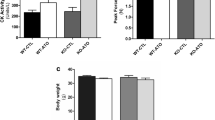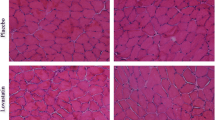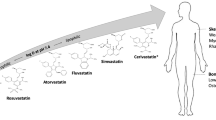Abstract
Myalgia and muscle weakness may appreciably contribute to the poor adherence to statin therapy. Although the pathomechanism of statin-induced myopathy is not completely understood, changes in calcium homeostasis and reduced coenzyme Q10 levels are hypothesized to play important roles. In our experiments, fluvastatin and/or coenzyme Q10 was administered chronically to normocholesterolaemic or hypercholaestherolaemic rats, and the modifications of the calcium homeostasis and the strength of their muscles were investigated. While hypercholesterolaemia did not change the frequency of sparks, fluvastatin increased it on muscles both from normocholesterolaemic and from hypercholesterolaemic rats. This effect, however, was not mediated by a chronic modification of the ryanodine receptor as shown by the unchanged ryanodine binding in the latter group. While coenzyme Q10 supplementation significantly reduced the frequency of the spontaneous calcium release events, it did not affect their amplitude and spatial spread in muscles from fluvastatin-treated rats. This indicates that coenzyme Q10 supplementation prevented the spark frequency increasing effect of fluvastatin without having a major effect on the amount of calcium released during individual sparks. In conclusion, we have found that fluvastatin, independently of the cholesterol level in the blood, consistently and specifically increased the frequency of calcium sparks in skeletal muscle cells, an effect which could be prevented by the addition of coenzyme Q10 to the diet. These results support theories favouring the role of calcium handling in the pathophysiology of statin-induced myopathy and provide a possible pathway for the protective effect of coenzyme Q10 in statin treated patients symptomatic of this condition.








Similar content being viewed by others
References
Antons KA, Williams CD, Baker SK, Phillips PS (2006) Clinical perspectives of statin-induced rhabdomyolysis. Am J Med 119:400–409
Banach M, Serban C, Sahebkar A, Ursoniu S, Rysz J, Muntner P, Toth PP, Jones SR, Rizzo M, Glasser SP, Lip GY, Dragan S, Mikhailidis DP (2015) Effects of coenzyme Q10 on statin-induced myopathy: a meta-analysis of randomized controlled trials. Mayo Clin Proc 90(1):24–34
Bookstaver DA, Burkhalter NA, Hatzigeorgiou C (2012) Effect of coenzyme Q10 supplementation on statin-induced myalgias. Am J Cardiol 110(4):526–529
Bruckert E, Hayem G, Dejager S, Yau C, Bégaud B (2005) Mild to moderate muscular symptoms with high-dosage statin therapy in hyperlipidemic patients—the PRIMO study. Cardiovasc Drugs Ther 19(6):403–414
Csernoch L, Szentesi P, Sárközi S, Szegedi C, Jóna I, Kovács L (1999) Effects of tetracaine on sarcoplasmic calcium release in mammalian skeletal muscle fibres. J Physiol 515(3):843–857
Daugird AJ, Crowell K, Saseen J (2003) Clinical inquiries. Do statins cause myopathy? J Fam Pract 52:973–977
EFSA Panel on Dietetic Products, Nutrition and Allergies (2010) Scientific Opinion on the substantiation of health claims related to coenzyme Q10 and contribution to normal energy-yielding metabolism (ID 1508, 1512, 1720, 1912, 4668), maintenance of normal blood pressure (ID 1509, 1721, 1911), protection of DNA, proteins and lipids from oxidative damage (ID 1510), contribution to normal cognitive function (ID 1511), maintenance of normal blood cholesterol concentrations (ID 1721) and increase in endurance capacity and/or endurance performance (ID 1913) pursuant to Article 13(1) of Regulation (EC) No 1924/2006. EFSA J 8(10):1793
Evans CD, Eurich DT, Lamb DA, Taylor JG, Jorgenson DJ, Semchuk WM, Mansell KD, Blackburn DF (2009) Retrospective observational assessment of statin adherence among subjects patronizing different types of community pharmacies in Canada. J Manag Care Pharm 15(6):476–484
Fernandez G, Spatz ES, Jablecki C, Phillips PS (2011) Statin myopathy: a common dilemma not reflected in clinical trials. Clevel Clin J Med 78(6):393–403
Füzi M, Palicz Z, Vincze J, Cseri J, Szombathy Z, Kovács I, Oláh A, Szentesi P, Kertai P, Paragh G, Csernoch L (2012) Fluvastatin-induced alterations of skeletal muscle function in hypercholesterolaemic rats. J Muscle Res Cell Motil 32(6):391–401
Gerber BL (2013) In vivo evaluation of atherosclerotic plaque inflammation and of anti-inflammatory effects of statins by 18F-fluorodeoxyglucose positron emission tomography. J Am Coll Cardiol 62(10):918–920
Glauert AM, Dingle JT, Lucy JA (1962) Action of saponin on biological cell membranes. Nature 196:953–955
Guarini G, Marzilli M (2013) Defining the role of high-dose statins in PCI. Am J Cardiovasc Drugs 3:189–197
Herrmann-Frank A, Richter M, Sarközi S, Mohr U, Lehmann-Horn F (1996) 4-Chloro-m-cresol, a potent and specific activator of the skeletal muscle ryanodine receptor. Biochim Biophys Acta 1289(1):31–40
Inoue R, Tanabe M, Kono K, Maruyama K, Ikemoto T, Endo M (2003) Ca2+-releasing effect of cerivastatin on the sarcoplasmic reticulum of mouse and rat skeletal muscle fibers. J Pharmacol Sci 93(3):279–288
Isaeva EV, Shkryl VM, Shirokova N (2005) Mitochondrial redox state and Ca2+ sparks in permeabilized mammalian skeletal muscle. J Physiol 565(Pt 3):855–872
Jackevicius CA, Mamdani M, Tu JV (2002) Adherence with statin therapy in elderly patients with and without acute coronary syndromes. JAMA 288(4):462–467
Johnson TE, Zhang X, Bleicher KB, Dysart G, Loughlin AF, Schaefer WH, Umbenhauer DR (2004) Statins induce apoptosis in rat and human myotube cultures by inhibiting protein geranylgeranylation but not ubiquinone. Toxicol Appl Pharmacol 200(3):237–250
Knoblauch M, Dagnino-Acosta A, Hamilton SL (2013) Mice with RyR1 mutation (Y524S) undergo hypermetabolic response to simvastatin. Skelet Muscle 3(1):22
Kon M, Kimura F, Akimoto T, Tanabe K, Murase Y, Ikemune S, Kono I (2007) Effect of Coenzyme Q10 supplementation on exercise-induced muscular injury of rats. Exerc Immunol Rev 13:76–88
Lanner JT, Georgiou DK, Dagnino-Acosta A, Ainbinder A, Cheng Q, Joshi AD, Chen Z, Yarotskyy V, Oakes JM, Lee CS, Monroe TO, Santillan A, Dong K, Goodyear L, Ismailov II, Rodney GG, Dirksen RT, Hamilton SL (2012) AICAR prevents heat-induced sudden death in RyR1 mutant mice independent of AMPK activation. Nat Med 18(2):244–251
Littlefield N, Beckstrand RL, Luthy KE (2014) Statins’ effect on plasma levels of coenzyme Q10 and improvement in myopathy with supplementation. J Am Assoc Nurse Pract 26(2):85–90
Löhn M, Fürstenau M, Sagach V, Elger M, Schulze W, Luft FC, Haller H, Gollasch M (2000) Ignition of calcium sparks in arterial and cardiac muscle through caveolae. Circ Res 87(11):1034–1039
Lotteau S, MacDougall D, Steele D, Calaghan S (2015) Statin induced myopathy: a role for mitochondrial Ca2D and no in enhanced sarcoplasmic reticulum Ca2+ Leak. Biophys J 108(2):567a
Lukács B, Sztretye M, Almássy J, Sárközi S, Dienes B, Mabrouk K, Simut C, Szabó L, Szentesi P, De Waard M, Ronjat M, Jóna I, Csernoch L (2008) Charged surface area of maurocalcine determines its interaction with the skeletal ryanodine receptor. Biophys J 95(7):3497–3509
Marcoff L, Thompson PD (2007) The role of coenzyme Q10 in statin-associated myopathy: a systematic review. J Am Coll Cardiol 49(23):2231–2237
Mihaylova B, Emberson J, Blackwell L, Keech A, Simes J, Barnes EH, Voysey M, Gray A, Collins R, Baigent C (2012) The effects of lowering LDL cholesterol with statin therapy in people at low risk of vascular disease: meta-analysis of individual data from 27 randomised trials. Lancet 380(9841):581–590
Nakahara K, Kuriyama M, Sonoda Y, Yoshidome H, Nakagawa H, Fujiyama J, Higuchi I, Osame M (1998) Myopathy induced by HMG-CoA reductase inhibitors in rabbits: a pathological, electrophysiological, and biochemical study. Toxicol Appl Pharmacol 152(1):99–106
Oddoux S, Brocard J, Schweitzer A, Szentesi P, Giannesini B, Brocard J, Fauré J, Pernet-Gallay K, Bendahan D, Lunardi J, Csernoch L, Marty I (2009) Triadin deletion induces impaired skeletal muscle function. J Biol Chem 284(50):34918–34929
Padra JT, Seres I, Oláh A, Fenyvesi F, Paragh G, Paragh G, Csernoch L, Fóris G, Kertai P (2014) A comparative study on dyslipidaemia inducing diets in various rat strains. Acta Physiol Hung 101(2):250–258
Päivä H, Thelen KM, Van Coster R, Smet J, De Paepe B, Mattila KM, Laakso J, Lehtimäki T, von Bergmann K, Lütjohann D, Laaksonen R (2005) High-dose statins and skeletal muscle metabolism in humans: a randomized, controlled trial. Clin Pharmacol Ther 78(1):60–68
Sacher J, Weigl L, Werner M, Szegedi C, Hohenegger M (2005) Delineation of myotoxicity induced by 3-hydroxy-3-methylglutaryl CoA reductase inhibitors in human skeletal muscle cells. J Pharmacol Exp Ther 314(3):1032–1041
Salarieh A, Soler AP, Axiotis CA (2004) Overexpression of neural cell adhesion molecule in regenerative muscle fibers in 3-hydroxy-3-methylglutaryl coenzyme: a reductase inhibitor-induced rhabdomyolysis. Appl Immunohistochem Mol Morphol 12(3):234–239
Sárközi S, Szegedi C, Lukács B, Ronjat M, Jóna I (2005) Effect of gadolinium on the ryanodine receptor/sarcoplasmic reticulum calcium release channel of skeletal muscle. FEBS J 272(2):464–471
Schaefer WH, Lawrence JW, Loughlin AF, Stoffregen DA, Mixson LA, Dean DC, Raab CE, Yu NX, Lankas GR, Frederick CB (2004) Evaluation of ubiquinone concentration and mitochondrial function relative to cerivastatin-induced skeletal myopathy in rats. Toxicol Appl Pharmacol 194(1):10–23
Sirvent P, Mercier J, Vassort G, Lacampagne A (2005) Simvastatin triggers mitochondria-induced Ca2 + signaling alteration in skeletal muscle. Biochem. Biophys. Res. Commun. 329(3):1067–1075
Sirvent P, Fabre O, Bordenave S, Hillaire-Buys D, Raynaud De Mauverger E, Lacampagne A, Mercier J (2012) Muscle mitochondrial metabolism and calcium signaling impairment in patients treated with statins. Toxicol Appl Pharmacol 259(2):263–268
Skarlovnik A, Janić M, Lunder M, Turk M, Šabovič M (2014) Coenzyme Q10 supplementation decreases statin-related mild-to-moderate muscle symptoms: a randomized clinical study. Med Sci Monit 20:2183–2188
Somodi S, Balajthy A, Szilágyi O, Pethő Z, Harangi M, Paragh G, Panyi G, Hajdu P (2013) Analysis of the K+ current in human CD4+ T lymphocytes in hypercholesterolemic state. Cell Immunol 281(1):20–26
Szabó LZ, Vincze J, Csernoch L, Szentesi P (2010) Improved spark and ember detection using stationary wavelet transforms. J Theor Biol 264(4):1279–1292
Szegedi C, Sárközi S, Herzog A, Jóna I, Varsányi M (1999) Calsequestrin: more than ‘only’ a luminal Ca2+ buffer inside the sarcoplasmic reticulum. Biochem J 337(1):19–22
Szentesi P, Szappanos H, Szegedi C, Gönczi M, Jóna I, Cseri J, Kovács L, Csernoch L (2004) Altered elementary calcium release events and enhanced calcium release by thymol in rat skeletal muscle. Biophys J 86(3):1436–1453
Taylor F, Huffman MD, Macedo AF, Moore TH, Burke M, Davey Smith G, Ward K, Ebrahim S (2013) Statins for the primary prevention of cardiovascular disease. Cochrane Database Syst Rev 1:CD004816. doi:10.1002/14651858.CD004816.pub5
Taylor BA, Lorson L, White CM, Thompson PD (2015) A randomized trial of coenzyme Q10 in patients with confirmed Statin Myopathy. Atherosclerosis. 238(2):329–335
Tomlinson SS, Mangione KK (2005) Potential adverse effects of statins on muscle. Phys Ther 85:459–465
Waclawik AJ, Lindal S, Engel AG (1993) Experimental lovastatin myopathy. J Neuropathol Exp Neurol 52(5):542–549
Acknowledgments
This work was supported by grants from the Hungarian Scientific Research Found (OTKA K 81923), from the Hungarian Ministry of Human Resources (TÁMOP-4.2.1/B-09/1/KONV-2010-0007, TÁMOP-4.2.2/B-10/1-2010-0024, and TÁMOP-4.2.2.A-11/1/KONV-2012-0025). This research was supported by the European Union and the State of Hungary, co-financed by the European Social Fund in the framework of TÁMOP-4.2.4.A/2-11/1-2012-0001 ‘National Excellence Program’ (DB, VJ).
Author information
Authors and Affiliations
Corresponding author
Additional information
J. Vincze and Á. Jenes have contributed equally to this work.
Rights and permissions
About this article
Cite this article
Vincze, J., Jenes, Á., Füzi, M. et al. Effects of fluvastatin and coenzyme Q10 on skeletal muscle in normo- and hypercholesterolaemic rats. J Muscle Res Cell Motil 36, 263–274 (2015). https://doi.org/10.1007/s10974-015-9413-5
Received:
Accepted:
Published:
Issue Date:
DOI: https://doi.org/10.1007/s10974-015-9413-5




